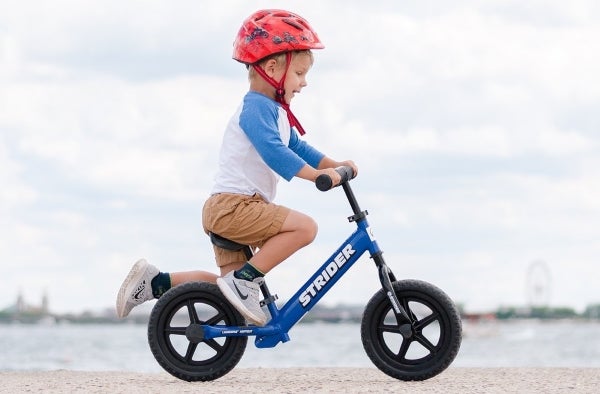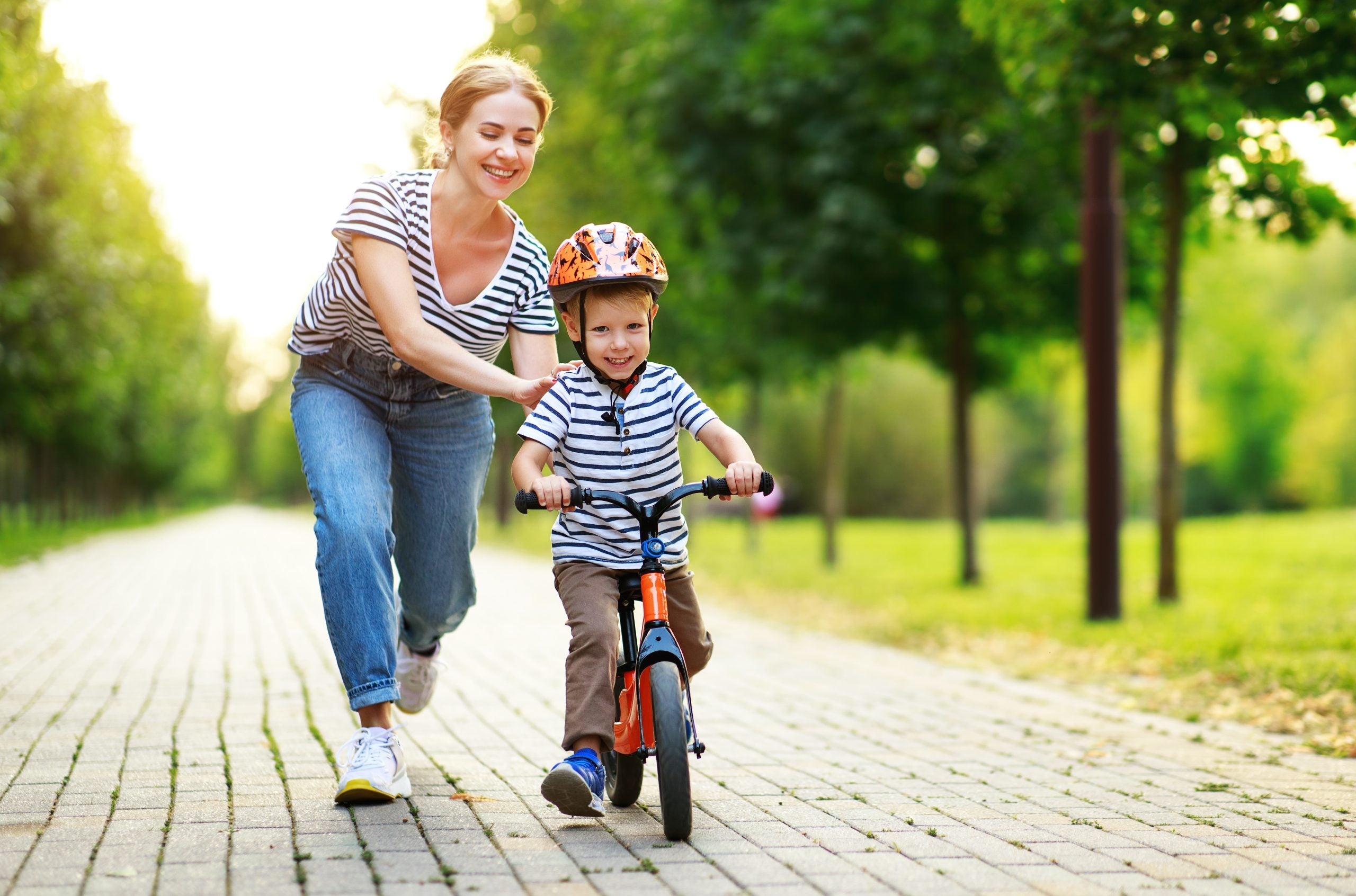
Our Editors independently research, test, and rate what we feel are the best products. We use affiliate links and may receive a small commission on purchases.
There are some significant differences between balance bikes which will determine the right product for your child at his/her age and skill level. A detailed comparison of the top-rated balance bikes is included below.
Also see a comprehensive buyers guide called, How To Choose The Best Balance Bike and to see what others are buying see Amazon Bestsellers.
Looking for a different type of bike? Read our comprehensive guide to every type of bicycle.
Best Balance Bikes
| Strider Sport Balance Bike | Co-op Cycles REV 12 Kids' Balance Bike | GOMO Balance Bike | |
|---|---|---|---|
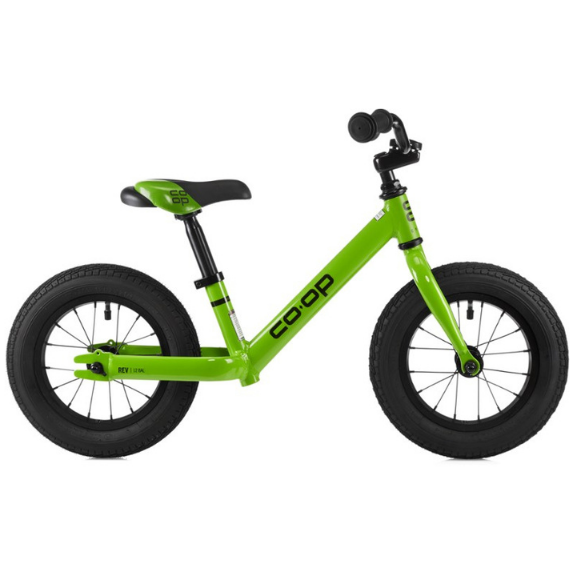 | |||
| Age Range: | 18 months to 5 years | 20 months to 5 years | 2 to 5 years |
| Wheel Size: | 12″ | 12″ | 12″ |
| Built-in Footrest: | Yes | No | Yes |
| Hand Brakes: | No | No | No |
| Convertible to a Pedal Bike: | No | No | No |
| REI |
Quick Answer: The Best-Rated Balance Bikes – 2022
Also see: Best Balance Bikes – YouTube Video Review
Balance Bike Reviews
#1 Strider Sport Balance Bike
![]()
Features of the Strider Sport Balance Bike
- Age range: 18 months to 4 years
- Wheel size: 12″
- Built-in footrest? Yes.
- Hand brakes? No.
- Convertible to a pedal bike? No.
- Adjustable Handlebar and Seat
- Cushioned Seat
- Padded Handlebar
- Steel Frame
The handlebars and seat of this bike can be adjusted to accommodate the growth of your child up to 5 years. If your kids are willing to share, you can simply readjust it when it’s time for each of them to play.
The design is more advanced than the Classic. It can accommodate future modifications and upgrades such as new tires and a foot brake. This bike is the perfect gift if you’re looking for a balance bike for 4-year-olds because of the many modifications that you can add.
The age rating for this balance bike begins at 18 months, and that’s why the chassis weighs just 6.7 pounds so that it’s easier for children to navigate.
The grips on the handles are properly sized for toddlers as well so that they have better control over the bike.
Not to mention, there are even footrests so that they can learn to glide and balance.
The features of this design are safe, as well as comfortable. The cushioned seat and padded handlebar provide sung surfaces, so your child doesn’t face any discomfort while riding for longer periods of time.
With the frame made out of durable steel, rest assured that this Strider balance bike can withstand much wear and tear.
Meanwhile, the puncture-proof tires won’t make you endure the hassles of maintenance anytime sooner either. Available in a wide range of colors, it’s well-suited to be a boy’s balance bike or a girl’s balance bike as well.
#2 Co-op Cycles REV 12 Kids’ Balance Bike
Features of the Co-Op Cycles Rev 12 Kids’ Balance Bike
- Age range: 20 months to 4 years
- Wheelsize: 12″
- Built-in footrest? No.
- Hand brakes? No.
- Convertible to a pedal bike? No.
- Adjustable seat and handlebars
- Step-thru to easily get on and off
- Pneumatic tires
- Lightweight frame
Co-Op Cycles is REI’s house brand of bikes. The Rev 12 is a great option because of its lightweight aluminum frame. Pneumatic tires can be a benefit or a drawback, depending on your level of expertise in maintaining the bike. Parents will have to add air to and, occasionally, replace tubes when pint-sized riders encounter thorns, but they provide a much better ride than solid tires.
The Rev 12 features an adjustable seat and handlebars so that it grows with your child.
The bike itself weighs 9 pounds, which is why the age rating starts a little higher than that of the Strider balance bike but overall, it’s maneuverable and a great option for young riders.
Check price at REI
#3 GOMO Balance Bike
Features of the GOMO Balance Bike
- Age range: 2 to 3 years
- Wheelsize: 12″
- Built-in footrest? Yes.
- Hand brakes? No.
- Convertible to a pedal bike? No.
- Adjustable Seat and Handlebar
- Eco-Friendly fiber-based frame
- Rubber Tires
This feature makes it an excellent choice if you’re seeking a balance bike for two-year-olds. The height of the seat can be adjusted according to your child’s height so that there’s more space between their legs and the ground.
While this balance bike isn’t as lightweight as its opponents, it weighs slightly over 9 pounds which are pretty adequate since the starting age for riding this bike is two years.
The steering on the design is limited which means that your child can only turn around 30 degrees left and right to avoid making a big turn that could cause them to fall. This feature also keeps kids from feeling scared of falling off their balance bike.
The footrest is part of the design and can help your child develop a sense of balance while riding. Some parents may have doubts about buying this bike because it comprises of a fiber-based material that’s similar to plastic but it’s still pretty sturdy. The fiber has the advantage of being resistant to the damage caused by elements such as rain. The assembly is quick, and that means you can take it apart and bring it along on a trip too.
If you need a balance bike for three-year-olds, then this is the one will suit your child well.
#4 Woom 1 Plus
Features of the Woom 1 Plus Balance Bike
- Age range: 3 to 6 years
- 14″ wheels
- Built-in footrest? Yes.
- Hand brakes? Yes. Front and Rear.
- Convertible to a pedal bike? No.
- Adjustable seat
- Adjustable handlebar
Before your child takes on pedaling, this balance bike will get them familiarized with the world of cycling through balancing and use dual hand brakes—just like on an adult’s bike.
The Woom 1 Plus features the company’s appropriately-named Surfboard Footrest, which allows kids to rest their feet while balance while coasting, completely eliminating the need for training wheels.
Check price at Woom Bikes
#5 Strider 14X Balance Bike
Features of the Strider 14X
- Age range: 3 to 6 years
- Wheel size: 14″
- Built-in footrest? Yes.
- Hand brakes? No. Rear Coaster Brake.
- Convertible to a pedal bike? Yes.
- Slim pedals allow the bike child to choose when to pedal or glide
- Lots of colorways
- Adjustable Seat
- Adjustable Handlebars
- Non-slip Handlebar Grips
- Puncture-proof EVA Tires
- Cushioned Seat
This is the best balance bike to get for young riders who are just about ready to make the leap to a bike with pedals. A true marvel of a balance bike, the Strider 14X allows the rider to balance when they want and when the time comes for pedals, you can install them with an 8mm Allen key and you’re set to go.
The pedals are very slim, so the balance bike is still in full effect, and if your child would like to balance and glide they can easily. The Strider 14X comes with a coaster brake and cog installed from the get-go with a slick cover to keep hands and pants safe from harm.
It boasts an easily adjustable padded seat and stem that can take a beating. Real pneumatic tires round out this cool ride.
Best Balance Bikes Comparison Table
| Best Balance Bikes | Age Range | Wheel Size | Built-in Footrest | Hand Brakes | Convertible to a Pedal Bike | |
|---|---|---|---|---|---|---|
| Strider Sport Balance Bike | 18 months to 5 years | 12″ | Yes | No | No | |
| Co-op Cycles REV 12 Kids' Balance Bike |  | 20 months to 5 years | 12″ | No | No | No |
| GOMO Balance Bike | 2 to 5 years | 12″ | Yes | No | No | |
| Woom 1 Plus | 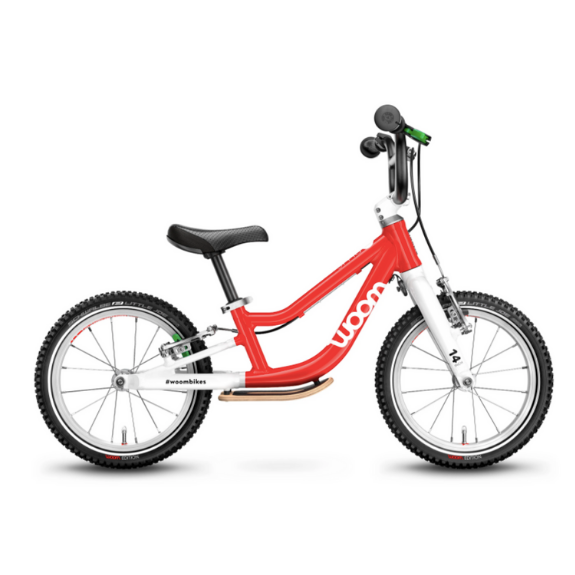 | 3 to 5 years | 14″ | Yes | Yes. Front and Rear. | No |
| Strider 14X Balance Bike | 3 to 5 years | 14″ | Yes | No. Rear Coaster Brake. | Yes |
How To Choose The Best Balance Bike
- Size Of The Bike
- Height of The Seat
- Weight of The Bike
- Tires on The Bike
- Air Inflated Tires
- Foam-Based Tires
- Materials
Balance bikes teach kids from about 18 months – 5 years old how to eventually master a pedal bike in a variety of ways.
They start by walking while straddling the balance bike, and then eventually scooting or gliding with their feet off the ground and coasting.
It’s not just educational and therapeutic for any child – but also FUN! So what is the best balance bike for kids?
Times have changed and so has the nature of children’s favorite pastime- riding their bike around the block. The creation of the balance bike is definitely one that could be accredited, considering it gives children a headstart on the pedal bike.
You’re probably wondering which balance bike is best, but it often depends on what you prioritize the most. This reason is why it’s essential to go through a buying guide before deciding as to purchasing a balance bike.
All pedal-less bikes would be considered as adequate to get the job done yet they still differ in the experience they offer to a child.
Many important things have to be taken into consideration when buying a balance bike for toddlers which is why we’ve compiled a list of them for you.
Size Of The Bike
The size of a balance bike tops the list as the most important factor to consider because you have to buy these according to your child’s current size instead of later on.
That’s because getting a balance bike for 4-year old for a toddler won’t be effective and your child may end up having a negative experience with their first ride.
The company measures the size of a kid’s balance bike from the wheels, which can be either 12 or 14 inches.
This can give you an idea of what type of balance bike you should get for your child. However, this isn’t the only thing you must consider about size, and you should also take the maximum height of the seat into account.
Height of The Seat
A bike with an adjustable seat can prove to be more effective than one that doesn’t.
The reason for this is that you can settle for bigger wheels while making sure to get a balance bike that has an adjustable seat that you can lower according to your child’s needs.
Here are a few tests you should do once the bike which you have ordered, arrives.
- Can your child easily stand over the bike without being disturbed by the seat?
- Can he/she walk with the bike between his/her legs?
- Can your child sit on the bike in an ergonomic position?
- Do your child’s hands easily reach the handlebars while sitting on the balance bike?
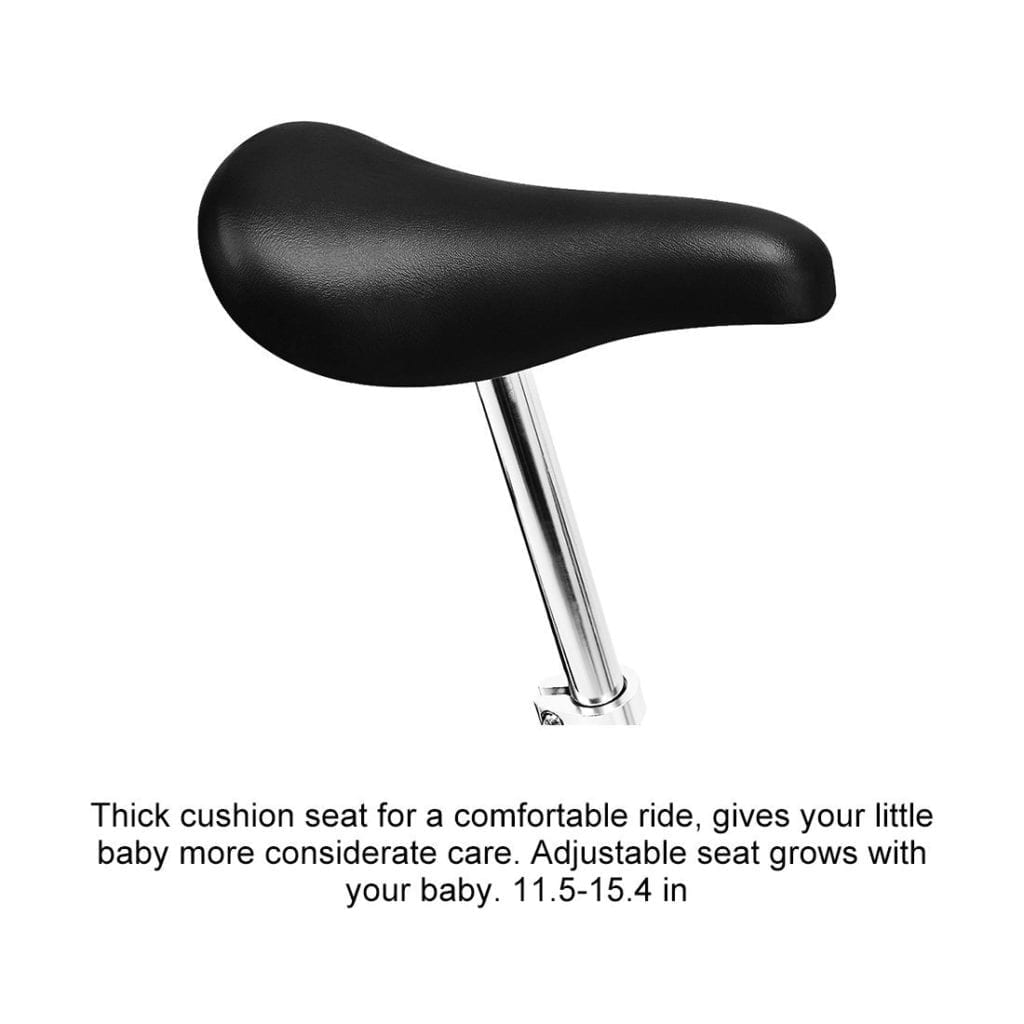
The height of a seat isn’t dependent upon the size of the tires, and they usually begin at the height of 10 inches and move upwards till the adult range of 40 inches.
To be able to ride a balance bike properly, your child’s feet should touch the ground and be able to push themselves forward while sitting on the bike.
A bike that will perfectly fit your child should have a seat height that is 1.5 inches less than the length of their feet and crotch.
Weight of The Bike
Essentially, buying a balance bike that weighs over 30% of your child means ruining the experience because it will be difficult to lug around. If you need a balance bike for two-year-olds, getting a ten-pound one would be a bad idea.
That said, you’ll have to keep in mind that your child will be using this bike until he/she’s five years old, so it’s better to invest in a lightweight but sturdy model.
But overall, it mostly depends on your kid’s personality and lifestyle. Kids that are athletic may have no problem lugging around heavier bikes, which is why you can buy one with extra features.
On the other hand, children that are petite or less athletic may have trouble with bikes that are heavier than 30% of their weight which is why it’s best to stick to the recommended weight range.
Tires on The Bike
Tires themselves come in various forms which include foam, rubber, hard plastic, and air inflated. Even though there are many types, balance bikes usually comprise of foam and air inflated tires.
Air Inflated Tires
These take precedence as being commonly used in all kinds of bikes because they provide a cushioned ride and better grip on the road or curb.
The pattern on this category of tires is either knobby, similar to that on bikes used to ride on mountains or standard type used for roads.
It’s important that you understand the terrain or surface that y our child will be riding his/her bike on before purchasing one.
Bumpy and rough terrain would require that your child’s balance bike has tires with a knobby pattern to act as shock absorbers that can promote an enjoyable ride.
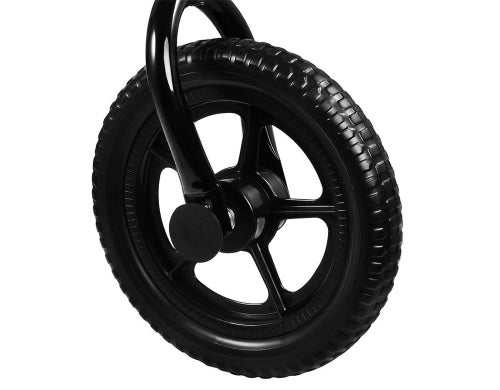
The downside of air-inflated tires is that they are susceptible to flats, if your child rides over broken glass then it’s possible that the tire will suffer from a puncture.
A simple solution to this problem is to apply sealant inside the tire because it quickly covers any cuts or holes which may have affected your tire.
This way, you can avoid buying another tire. A way to avoid flat tires completely is to ensure that the pressure in them remains high so that they are less prone to being punctured.
Foam-Based Tires
These are a durable take on the traditional inflatable tires, and they are often preferred by parents because they require little to no maintenance.
Even though they may not provide as much of a grip as their inflated counterparts, they do sit lower which makes them well-suited for balance bikes aimed towards smaller children.
Materials
Balance bikes are designed to be made using a selection of base materials. These can range somewhere between, aluminum, plastic, and wood. It’s a no-brainer that the price will indicate the cost of the material.
Aluminum
Aluminum is a material used for the best balance bikes because of its durability and lightweight properties that surpass others. However, aluminum-based balance bikes will come for a higher price than others so be ready for a hefty price tag.
Wood
Wooden balance bikes are gaining popularity because of their aesthetic appeal and adequate durability. They don’t, however, provide the same durability and they are prone to damage from exposure to the elements.
Plastic
A toddler bike is usually made of plastic because it’s a cheaper alternative and weighs less as well. It’s better suited to withstand the wear and tear of excessive use.
Moreover, it’ll be better at avoiding damage caused by exposure to sun and moisture, unlike wood.
Thanks for reading The 5 Best Balance Bikes Reviewed. We hope this article has helped you to discover the best balance bike for the money to suit your little one.
Also see these informative articles: Top 10 Road Biking Routes in the United States and How To Get Started Road Biking – A Beginner’s Guide.
Best Balance Bike Frequently Asked Questions
What age is best for a balance bike?
Many toddlers can start scooting around on balance bikes by the time they are 18 to 24-months old. T
Is a balance bike worth it?
Yes! Balance bikes are the best way to get kids started on bikes. They also hold their value well since new parents are eager to buy them used.
Are balance bikes better than training wheels?
Without a doubt, balance bikes are the best way to teach children how to ride. While most adults in North America learned to ride with training wheels, they have significant drawbacks. Training wheels don’t teach children the basics of how to balance, which makes it harder to learn to ride without training wheels. Balance bikes help children learn this basic still before moving on to pedaling and braking.
What balance bike is best for a 2-year-old?
Most toddlers are ready to start using a balance bike around two years of age. There are a lot of great balance bikes for 2-year-olds. After testing numerous models, we think the Strider Sport 12 is the best balance bike for 2-year-old riders.
Are all balance bikes the same size?
Just like adult bikes, balance bikes come in different sizes to fit different-sized riders. The smallest balance bikes use 12″ wheels, while those designed for older riders (aged 3-5 years old) often come with 14″ and 16″ wheels.
Is 5 too old for a balance bike?
It’s never too late to learn how to ride a bike. Many companies make balance bikes to fit larger children, a few even make balance bikes for adults! Balance bikes with 14″, 16″ or even 20″ wheels are the best options for older riders.
How We Researched
To come up with the top balance bikes, we researched a variety of sources for reviews such as CompetitiveCyclist, JensenUSA, REI, EVO along with our own personal experiences.
We also consulted online magazines for product research and reviews to get as much unbiased information as we could. To help weed out fake reviews we used Fakespot.com to make sure we only looked at genuine reviews.
With so much quality gear available, we had to narrow it down based on what we felt were the best options for the price. The staff authors have a wide and varied background in road cycling, racing and bike packing.
The authors have decades of experience in cycling and eager to share their knowledge with readers.
To help narrow down the selection we used personal experiences along with recommendations from fellow parents, cycling journalists and bike shops.
After extensive research, we came up with our list to help you choose the right one for you.
Notice:
OutsidePursuits.com is a participant in the Amazon Services LLC Associates Program, an affiliate advertising program. OutsidePursuits.com earns fees from products sold through qualifying purchases by linking to Amazon.com. Amazon offers a commission on products sold through their affiliate links.

